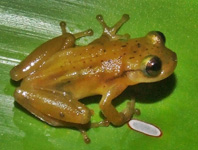Abstract
Astropecten cingulatus is a conspicuous species, which displays a large superomarginal plate series on the abactinal surface. Herein we describe a new species from off the Texas coast that shows the superficial appearance of A. cingulatus, including these large superomarginal plates, but with armature differing from that of typological A. cingulatus. This species shows the actinal surface of the inferomarginal plates without the squamules present on A. cingulatus. In addition, the adambulacral plates possessed but a single central large spine surrounded by a circle of spines rather than spine rows. The abactinal paxillar region was also very narrow. Statistical analysis of these and other morphological characters showed the specimens differed significantly from those of A. cingulatus. The regression of the slope of R:SM# vs. R was significant but the intercept was not. Therefore the two species are indistinguishable at small sizes based on R:SM. Compared to known Atlantic Astropecten spp. these observed characters warrant the description of a new species, Astropecten karankawai, for the specimens from off the coasts of Texas and Mexico.
References
Bernasconi, I. (1941) Los equinodermos de la expedicion del Buque oceanográfico “Comodoro Rivadavia” A.R.A. Physis, 19, 37–49.
Bernaconi, I. (1956) Equinoideos y asteroideos de la colecciön del Instituto Oceanográfico de la Universidad de San Pablo. Segunda contribuciön. Boletim do Instituto Oceanográfico, 7 (1–2), 119–148.
https://doi.org/10.1590/S0373-55241956000100008
Carrera-Rodríguez, C. & Tommasi, L.R. (1977) Asteroidea de la plataforma continental de Rio Grande do Sul (Brasil), coleccionados durante los viajes del N/Oc. “Prof. W. Besnard” para el Projecto Rio Grande do Sul, Boletim do Instituto Oceanográfico, 26 (1), 51–130.
http://dx.doi.org/10.1590/S0373-55241977000100004
Clark, A.M. & Downey, M.E. (1992) Starfishes of the Atlantic. Chapman & Hall, London, 663 pp.
Döderlein, L. (1917) Die Asteriden der Siboga-Expedition. I. Die Gattung Astropecten und ihre Stammesgechichte. Siboga-Expeditie, 46 (a), 1–190.
Downey, M.E. (1973) Starfishes from the Caribbean and the Gulf of Mexico. Smithsonian Contributions to Zoology, 126, 1–158.
https://doi.org/10.5479/si.00810282.126
Lawrence, J.M. & Cobb, J. (2017) Validation of Astropecten jarli Madsen, 1950 and implications for A. cingulatus Sladen, 1883 (Paxillosida: Astropectinidae). Zootaxa, 4269 (1), 101–114.
https://doi.org/10.11646/zootaxa.4269.1.4
Pawson, D.L., Vance, D.J., Messing, C. & Solís-Marín, F.A. (2009) Echinodermata of the Gulf of Mexico. In: Felder, D.L. & Camp, D.K. (Eds.), Gulf of Mexico origin, waters and biota. Vol. 1. Texas A&M University Press, College Station, pp. 1177–1204.
Sladen, W.P. (1883) The Asteroidea of H.M.S. ‘Challenger’ Expedition—Part II. Journal of the Linnean Society. Zoology, 17, 247–269.
https://doi.org/10.1111/j.1096-3642.1883.tb02022.x
Sladen, W. (1889) The Asteroidea. Report of the Scientific Results of the Voyage of H.M.S. Challenger during the years 1873–76, 30, 1–395.
Vázquez-Bader, A.R., Laguarda-Figueras, A., Gracia, A., Solís-Marín, F.A., Celalya-Hernández, E.V. & Durán-González, A. (2008) Seasonal changes in the density and species composition of the epifauna of echinoderms recorded from the southwestern Gulf of Mexico. Revista Biología Tropical, 56 (Supplement 3), 297–310.
Ventura, R.C.C., Veríssimo, I., Nobre, C.C. & Zama, P.C. (2007) Filo Echinodermata. In: Lavrado, H.P. & Viana M.S. (Eds.), Atlas de invertebrados marinhos de região central da zona econômica exclusiva brasileira. Parte 1. Museu National, Rio de Janeiro, pp. 217–257.

